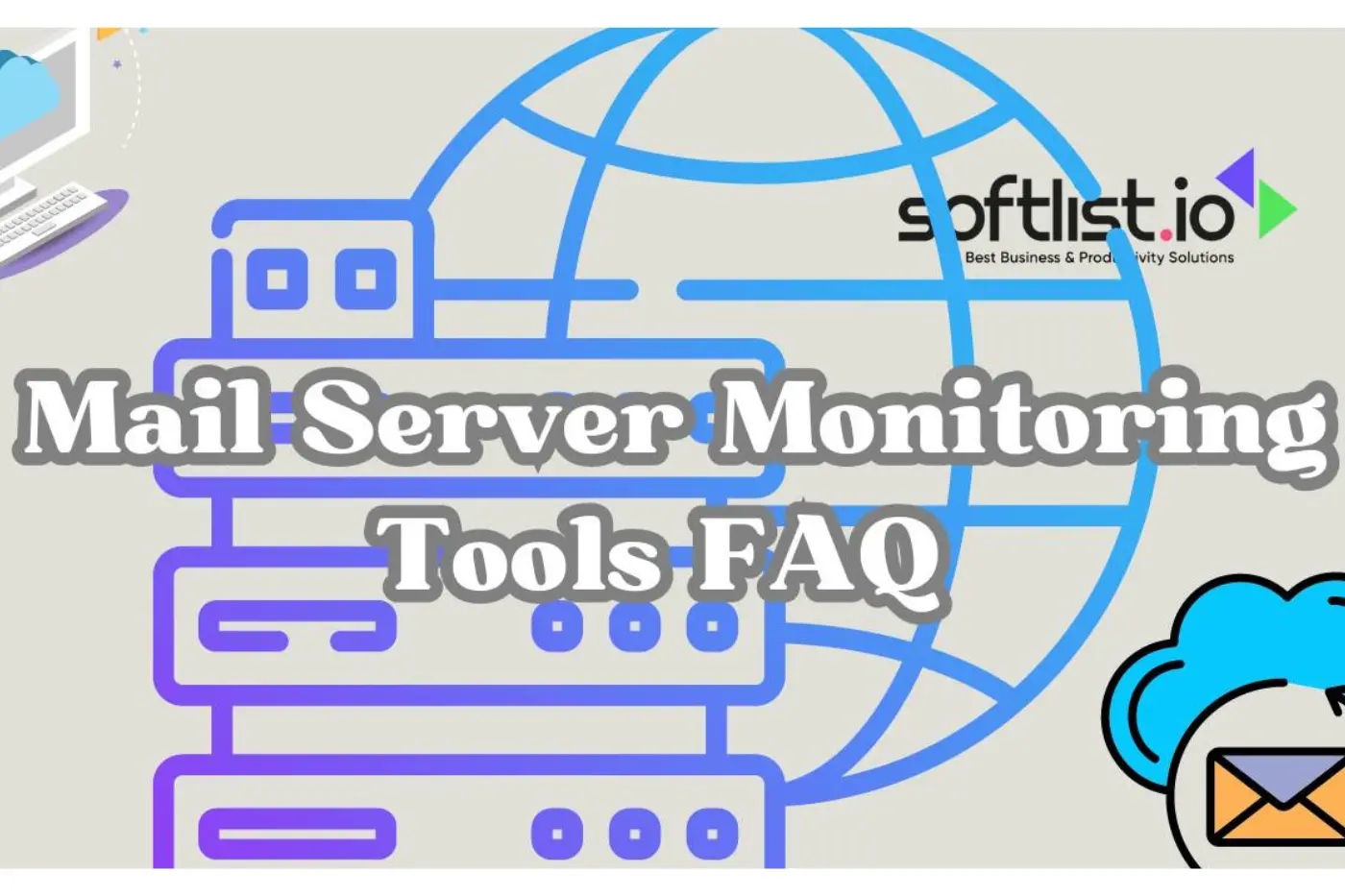You might be wondering why you need to monitor your mail server application and what a mail server monitoring tool is. When the experts say monitoring your server is essential, then it is time that you listen and take measures into your own hands. Keep reading this post to see why monitoring solutions can save you a lot of trouble and keep your inbox running smoothly.
What Are Some Popular Mail Server Monitoring Tools?
Source: Canva
There are many popular email server monitoring tools available. Mail servers should always be up and running, but they may sometimes experience downtime for various reasons. Simple Network Management Protocol (SNMP) facilitates the monitoring and management of network devices, allowing administrators to gather information efficiently and proactively address issues for optimal network performance.
Mail server monitoring tools can help you monitor your mail server status and ensure it is always running. You don’t need a mail server monitoring tool to ensure the reliability and security of your email infrastructure, but implementing one can significantly enhance proactive management and overall server performance monitoring.
The following are some popular email server monitoring tools:
Zabbix
Zabbix is an open-source tool that provides an active monitoring solution for all IT infrastructure components (including mail servers) in your organization. It offers complete control and support for email servers as well. If you want to track down the performance of your mail server, then you can use Zabbix for this purpose.
Nagios Core
Nagios Core is another open-source monitoring solution for your IT infrastructure. It allows you to monitor your servers’ overall CPU load, disk usage, RAM consumption, network bandwidth usage, and more. You can also monitor services like Apache web server or MySQL database server.
SolarWinds
This comprehensive solution lets you monitor your mail server and other aspects of your infrastructure, such as storage and network monitoring performance levels.
How Do These Tools Help Monitor the Performance of a Mail Server?
Source: Canva
Mail servers are one of the most essential parts of any business. They are used to send and receive emails and messages. The efficiency, along with the performance of a mail server, can have a direct impact on your business. If it is not functioning correctly, it can lead to errors in sending and receiving emails, which can be disastrous for any business.
This is why you should invest in tools like Mail Server Monitoring Tools. These tools will help you monitor the performance of your mail server and ensure that it is running smoothly at all times. You will also be able to detect any problems before they get out of hand or affect your business adversely.
Email server monitoring software comes in handy when you want to monitor the performance of your email servers. It helps you track how many emails are being sent and received by your users every day and how much bandwidth they are consuming. You can also find out if there are any issues related to viruses or spam messages being sent out by any employee, which may cause problems later on if left unchecked.
What Key Metrics Should Be Monitored for Effective Mail Server Management?
Source: Canva
Regularly tracking performance metrics is essential for businesses to assess the effectiveness of their strategies and make informed decisions for continuous improvement. Effective mail server management involves monitoring key metrics to ensure optimal performance, availability, and security.
Here are some essential metrics to monitor for comprehensive mail server management:
Server Uptime:
Monitor the server’s uptime to ensure continuous availability. Downtime can disrupt email services, so tracking uptime is critical.
Server Response Time:
Measure the time it takes for the server to respond to requests. Slow response times can impact user experience and indicate potential performance issues.
Email Delivery Times:
Monitor the time it takes for emails to be sent and received. This includes tracking queue lengths, processing times, and delivery success rates.
Server Resource Utilization:
Track CPU usage, memory consumption, disk space, and network bandwidth. High resource utilization can lead to performance degradation and should be addressed promptly.
Email Queue Length:
Keep an eye on the size of the email queue. A growing queue may indicate issues with email processing and could lead to delays in delivery.
Monitoring these key metrics provides a comprehensive view of the mail server’s health and performance. Administrators can maintain a reliable and secure email infrastructure by proactively addressing issues and ensuring the server operates within optimal parameters.
What Kind of Information Can I Get from a Mail Server Monitoring Tool?
Source: Canva
Mail server monitoring tools provide a wealth of information to help administrators assess their email infrastructure’s health, performance, and security. Here are some types of information you can typically gather from a mail server monitoring tool:
Server Health:
Uptime: The total time the mail server has been operational without downtime.
Response Time: The time it takes for the server to respond to requests, indicating server performance.
Email Delivery Metrics:
Queue Length: The number of emails waiting to be processed and delivered.
Delivery Time: The time it takes for emails to be sent and received.
Resource Utilization:
CPU Usage: The percentage of CPU resources utilized by the mail server.
Memory Consumption: The amount of system memory used by the mail server.
Disk Space: The space available on the server’s storage.
Security Information:
Authentication Attempts: Successful and failed login attempts, helping to detect unauthorized access.
Security Events: Alerts or notifications about potential security threats or suspicious activities.
Spam and Malware Detection:
Spam Filtering Effectiveness: Information on the volume of detected spam and the accuracy of spam filters.
Malware Detection: Alerts or reports on identifying malicious content in emails.
By aggregating and analyzing this information, administrators can comprehensively understand their mail server’s performance, troubleshoot issues, plan for future resource needs, and ensure email services’ overall reliability and security.
Why Do I Need to Install a Mail Server Monitoring Tool?
Source: Canva
Email servers are the backbone of your business. They help you stay in touch with your customers and partners; they allow you to send invoices and statements and help you communicate with your employees and colleagues. And when they don’t work correctly, they can cause significant problems for your business.
That’s why it’s essential to keep an eye on them. If you install a monitoring tool, you can ensure that everything is running smoothly and that no problems occur.
This will be visible on these tools if your mail server goes down or slows down significantly. You’ll get an email notification about it so that you can take action immediately.
Suppose you’re looking for a server monitoring tool to enhance the efficiency and security of your IT infrastructure. In that case, a feature-rich solution that provides real-time insights and proactive management capabilities.
This way, you can prevent potential problems from getting bigger and causing real damage to your business or brand reputation.
Another advantage of using a mail server monitoring tool is that it provides insight into how well the server performs. You’ll see how many emails per hour it processes (for example), what kind of connections are used for sending out emails (TCP or TLS), and whether there are any bottlenecks in the network infrastructure or elsewhere (for example).
Why Is Mail Server Monitoring Necessary?
Source: Canva
Monitoring the mail server is essential to ensure the smooth running of your business. It will help you eliminate any issues before they become a problem. Mail server monitoring is different across various solutions, as differences in features and capabilities make it crucial to choose a tool that precisely aligns with your organization’s specific needs and requirements.
Monitoring your mail server will allow you to detect and fix potential problems before they affect your users.
Mail servers are complex systems that can be affected by many factors. These include hardware, software, network connectivity, and more. If one of these components fails, it can cause delays and errors in delivering emails to users’ inboxes.
Email monitoring tools can help you detect issues related to senders or recipients’ email addresses or subjects. You can also use these tools to monitor performance data on your mail server, such as CPU usage, memory usage, disk space utilization, etc.
Best Mail Server Monitoring Tools
Conclusion
A good mail server monitoring tool should make it easier to identify problems that arise on the network and correct them before they cause any actual harm. Ensure that all your mail servers are being monitored, and regularly review the log files for any potential issues that may not be immediately obvious. We hope this has helped you. We invite you to explore our website for additional blog content.
FAQs
How do mail server monitoring tools detect issues?
Mail server monitoring tools detect issues through various metrics such as server response time, email delivery times, error rates, and server resource usage. They use predefined thresholds and patterns to trigger alerts when deviations from normal behavior occur.
Can mail server monitoring tools integrate with other systems?
Many mail server monitoring tools offer integrations with other systems and services. Standard integrations include email notification systems, collaboration platforms, and ticketing systems to streamline communication and issue resolution processes.
What types of alerts can mail server monitoring tools generate?
Mail server monitoring tools can generate alerts for various issues, including server downtime, slow response times, high email delivery failure rates, and security breaches. Alerts can be sent via email, SMS, or integrated with other communication channels.








